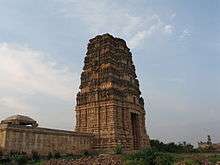Pemmasani Nayaks
Pemmasani Nayakas were a Kamma clan in the south Indian state of Andhra Pradesh[1]. They came into prominence during Vijayanagar times as feudatories of Gandikota under the rule of the kings at Vijayanagar.[2] Pemmasani Kamma kings traced their origin to Durjaya.They ruled as feudatory kings and army commandars over 300 years.[3][4][5][6]
Origin
According to inscriptions, the Pemmasani Kamma kings traced their origin to Durjaya vamsa[7].
History
The Pemmasani Nayaks ruled Yadiki, Gutti and Tadipatri with Gandikota as capital. The hard earned independence of Telugu land came to an end in fifty years with the martyrdom of Musunuri Kapaya Nayaka, a prominent Kamma warrior king in 1368 CE at the hands of Recherla Nayaks who colluded with Bahmani sultan. A large number of remaining Nayaks who served under Kapaya Nayaka migrated to Vijayanagar and swore allegiance to Bukka Raya, a close associate of Kapaya Nayaka for protecting the Hindu dharma in Dakshnapatha (Deccan). Among them, Pemmasani clan was one. Generations of Pemmasani clan were commanders under various families of the Vijayanagar empire.[8]
Extent of rule
The maximum extent of Pemmasanis feudatorial influence ranged from Gandikota to Kondapalli during the reign of Pemmasani Ramalinga Nayaka which includes areas like Gutti, Kurnool fort, Kondaveedu, Bellamkonda, Raichur, Kanchi, Tadipatri, Yadaki. [9] They ruled from Gandikota as their capital. Pemmasanis ruled mostly as autonomous rulers of Gandikota. Pemmasanis helped Araveeti kings to ascend the throne of great Vijayanagar Empire when there was power shift between Tuluva and Araveedu dynasties after the Battle of Tallikota in 1565 A. D. where the Vijayanagar empire under Tuluva dynasty rule faced huge defeat against combined forces of Deccan Sultanates. Pemmasanis played a crucial role in protecting the Vijayanagar empire. This is evident from the prime location of land that Vijayanagar kings have provided to Pemmasanis in Hampi as camp when they visited the city.
List of rulers
This is the list of Durjaya vamsa Musunuri dynasty Pemmasani Kamma Kings[10][11] :
- Pemmasani Kumara Veera Timma Nayaka (1350 - 1386) A. D.
- Pemmasani Dharma Nayaka (1386 - 1423) A. D.
- Pemmasani Timma Nayaka (1423 - 1446) A. D.
- Pemmasani Veera Timma Bhupathi (1446 - 1462) A. D.
- Pemmasani Chenna vibhudu (1462 - 1498) A. D.
- Pemmasani Ramalinga Nayaka (1498 - 1520) A. D.
- Pemmasani Timma Nayaka (1520 - 1542) A. D.
- Pemmasani Narasimha Nayaka (1542 - 1562) A. D.
- Pemmasani Bangaru Timma Nayaka (1562 - 1598) A. D.
- Pemmasani Timma Nayaka (1598 - 1623) A. D.
- Pemmasani Chinna Timma Nayaka (1623 - 1644) A. D.
- Sayapaneni (Pemmasani) Govindamamba (1644 - 1652) A. D.
Rule
The first ruler of Pemmasani clan was Pemmasani Timmanayudu who fought many a battle and won the trust of Bukka Raya.
Veera Thimma had a son by name Chennappa who had two sons Ramalinga Naidu and Peda Thimma Naidu. Ramalinga ruled Gandikota (1509-1530 CE) during the time of Krishna Deva Raya. Ramalinga had 80,000 soldiers under him and he played a crucial role in the victory of Krishna Deva Raya over the combined armies of Kalaburagi, Golkonda and Ahmednagar.[12] His exploits in the battle were extolled by many Telugu poets. He was the most feared by the Generals of Bijapur, Ahmednagar and Golconda.[13]
Thimma Naidu II participated in the expeditions of Krishna Deva Raya and captured Udayagiri, Addanki, Kondapalli, Rajahmundry and Katakam (Cuttack). He also played a crucial role in the conquest of Ummattur.[14]
After the death of Krishna Deva Raya in 1529, his son-in-law Rama Raya took control of the kingdom. The Bahamani sultan colluded with Salakam Timmaraja and raided Vijayanagar. Ramaraya took refuge in Gandikota. Bangaru Thimma Naidu vanquished Bahamanis in a fierce battle at Komali, killed Salakam Timmaraja and restored the throne to Ramaraya.[14]
Gandikota Fort Gallery


See Also
References
- ↑ "Sri Krishna deva rayalu vamsamoolalu", by Muthevi Ravindranath, 2018, Savithri Publications
- ↑ Vijayanagara, Burton Stein, Cambridge University Press, 1989, p.88, ISBN 0-521-26693-9
- ↑ Reporter, Staff. "Stone from Gandikota fort to be used". The Hindu. Retrieved 2016-12-21.
- ↑ Gandikota, by Tavva Obul Reddy, 2016, Telugu Samajam publishment
- ↑ https://m.femina.in/life/travel/be-amazed-at-indias-grand-canyon-gandikota-andhra-pradesh-82639-2.html
- ↑ https://m.economictimes.com/magazines/travel/canyon-viewpoint-soak-in-some-natural-beauty-while-camping-along-pennar-river/articleshow/45885349.cms
- ↑ Bellamkonda Inscription volume 7
- ↑ Vijayanagara, Burton Stein, Cambridge University Press, 1989, p.92, ISBN 0-521-26693-9
- ↑ "Aristocracy of South India by Vadivelu
- ↑ "Sri Krishna deva rayalu vamsamoolalu", by Muthevi Ravindranath, 2018, Savithri Publications
- ↑ Gandikota, by Tavva Obul Reddy, 2016, Telugu Samajam publishment
- ↑ Krishnadeva Raya, M. Rama Rao, 1971, National Book Trust, New Delhi, p. 17
- ↑ Tidings of the king: a translation and ethnohistorical analysis of the Rayavachakamu by Phillip B. Wagoner. University of Hawaii Press, Honolulu. 1993, Page 138-139, ISBN 0-8248-1495-9, https://www.questia.com/PM.qst?a=o&d=62773998
- 1 2 Further Sources of Vijayanagar History by K. A. Nilakanta Sastry, 1946, https://archive.org/details/FurtherSourcesOfVijayanagaraHistory